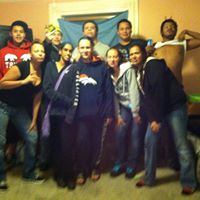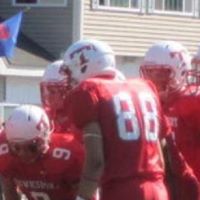Nicholas D Harvey
age ~64
from Stanwood, WA
- Also known as:
-
- Nicholas Dillon Harvey
- Nick D Harvey
Nicholas Harvey Phones & Addresses
- Stanwood, WA
- Dillon, MT
- Seeley Lake, MT
- Seattle, WA
- Sterling, IL
Isbn (Books And Publications)

Morals and the Meaning of Jesus: Reflections on the Hard Sayings
view sourceAuthor
Nicholas Peter Harvey
ISBN #
0829809473
Resumes

Nicholas Harvey
view source
Nicholas Harvey
view sourceName / Title
Company / Classification
Phones & Addresses
2018 156Th Ave NE, Bellevue, WA 98007
FH HOLDINGS, LLC
NICER AND AFFILIATES, LTD
PRODIVISION SERVICES LLC
Us Patents
-
System And Method For Creating Improved Overlay Network With An Efficient Distributed Data Structure
view source -
US Patent:7613796, Nov 3, 2009
-
Filed:Feb 3, 2003
-
Appl. No.:10/356961
-
Inventors:Nicholas J. Harvey - Redmond WA, US
Michael B. Jones - Redmond WA, US
Stefan Saroiu - Seattle WA, US
Marvin M. Theimer - Bellevue WA, US
Alastair Wolman - Seattle WA, US
Atul Adya - Bellevue WA, US -
Assignee:Microsoft Corporation - Redmond WA
-
International Classification:G06F 15/177
-
US Classification:709220, 709221, 709222
-
Abstract:A system and method for using skip nets to build and maintain overlay networks for peer-to-peer systems. A skip net is a distributed data structure that can be used to avoid some of the disadvantages of distributed hash tables by organizing data by key ordering. Skip nets can use logarithmic state per node and probabilistically support searches, insertions and deletions in logarithmic time.
-
Generalized Proximity Service
view source -
US Patent:8145699, Mar 27, 2012
-
Filed:May 30, 2003
-
Appl. No.:10/448903
-
Inventors:Jeffrey B. Parham - Redmond WA, US
Levon A. Esibov - Sammamish WA, US
Nicholas J. Harvey - Redmond WA, US
William B. Lees - Redmond WA, US -
Assignee:Microsoft Corporation - Redmond WA
-
International Classification:G06F 15/16
-
US Classification:709202, 709203, 709217, 709238
-
Abstract:A system and method for identifying network endpoints that provide a service of interest orders endpoints according to their network proximity to a requesting client. The requesting client may then contact the closest available providing endpoint, thus increasing the efficiency of usage of network resources while decreasing latency and enhancing reliability. In an embodiment of the invention, when a connection to the nearest providing endpoint cannot be established, a mechanism for locating a next-closest alternative endpoint is provided.
-
Generalized Proximity Service
view source -
US Patent:8250220, Aug 21, 2012
-
Filed:Jan 25, 2012
-
Appl. No.:13/358233
-
Inventors:Jeffrey B. Parham - Redmond WA, US
Levon A. Esibov - Sammamish WA, US
Nicholas J. Harvey - Redmond WA, US
William B. Lees - Redmond WA, US -
Assignee:Microsoft Corporation - Redmond WA
-
International Classification:G06F 15/16
-
US Classification:709227, 709202, 709203, 709217, 709238
-
Abstract:A system and method for identifying network endpoints that provide a service of interest orders endpoints according to their network proximity to a requesting client. The requesting client may then contact the closest available providing endpoint, thus increasing the efficiency of usage of network resources while decreasing latency and enhancing reliability. In an embodiment of the invention, when a connection to the nearest providing endpoint cannot be established, a mechanism for locating a next-closest alternative endpoint is provided.
-
Method For Designating Communication Paths In A Network
view source -
US Patent:20020120770, Aug 29, 2002
-
Filed:Feb 28, 2001
-
Appl. No.:09/795202
-
Inventors:Jeffrey Parham - Redmond CA, US
Mark Brown - Seattle WA, US
William Lees - Redmond WA, US
Van Vu - Bellevue WA, US
Laszlo Lovasz - Sammamish WA, US
Nicholas Harvey - Redmond WA, US
Katalin Vesztergombi - Sammamish WA, US -
International Classification:G06F015/173
-
US Classification:709/238000, 709/243000
-
Abstract:A method for designating communication paths in a computer network is provided, in which communication paths are designated for the transmission of data throughout a network. The network may have both recipient computers, which are the intended recipients of the data, and intermediary computers, which are not the intended recipients, but merely relay the data. Each intermediary computer is grouped with the “closest” recipient computer (i.e. the recipient computer with whom it is “least expensive” to communicate). Communication paths between the resulting groups are then identified. A representation of the network is then created. The representation replaces the intermediary computers with the inter-group communication paths, so that the inter-group communication paths appear to pass directly through the locations occupied by the intermediary computers. The created representation is then further processed so that the “least expensive” communication paths may be designated.
-
Method And System For Matching Network Clients And Servers Under Matching Constraints
view source -
US Patent:20040003066, Jan 1, 2004
-
Filed:Jun 26, 2002
-
Appl. No.:10/180734
-
Inventors:Nicholas Harvey - Redmond WA, US
Laszlo Lovasz - Sammamish WA, US -
Assignee:Microsoft Corporation - Redmond WA
-
International Classification:G06F015/173
-
US Classification:709/223000
-
Abstract:A method of finding an optimal match between clients and servers under given matching constraints utilizes a bipartite diagram in which the clients are presented as vertices on one side, the servers as vertices on the other side, and each possible client-server pairing allowed under the matching constraints as an edge connecting the vertices representing the client and the server. After an initial round of assignments is performed, the assignments are optimized by an optimization operation that iteratively applies a reassignment process. The reassignment process searches for a chain of servers starting with a server having a highest number of clients and ends with another server with a client number less than that of the first server by at least two, with each server in the chain except the end server having a client reassignable to the next server in the chain. Those reassignable clients are then reassigned along the chain such that the first server's client number is reduced by one and the end server's client number is reduced by one. The reassignment process is repeated until an optimal match is reached.
-
Method For Providing Guaranteed Distributed Failure Notification
view source -
US Patent:20050083834, Apr 21, 2005
-
Filed:Oct 17, 2003
-
Appl. No.:10/686658
-
Inventors:John Dunagan - Bellevue WA, US
Nicholas Harvey - Cambridge MA, US
Michael Jones - Redmond WA, US
Dejan Kostic - Durham NC, US
Marvin Theimer - Bellevue WA, US
Alastair Wolman - Seattle WA, US -
Assignee:Microsoft Corporation - Redmond WA
-
International Classification:G01R031/08
-
US Classification:370221000, 370245000
-
Abstract:A guaranteed distributed failure notification method is described, wherein a failure notification (FN) facility allows applications using the facility to create FN groups to which the application associates an application state. The application registers failure handlers with the FN facility on nodes in the FN group; each failure handler is associated with a specific FN group. When, on a given node, the FN facility learns of a failure in the FN group, the facility executes the associated failure handler on that node. System failures detected by the application are signaled to other FN group members using the facility. The facility detects system failures that occur in an overlay network on which the facility is implemented, and signals a failure notification to the other FN group members.
-
Scalable, Fault Tolerant Notification Method
view source -
US Patent:20050086469, Apr 21, 2005
-
Filed:Oct 17, 2003
-
Appl. No.:10/686620
-
Inventors:John Dunagan - Bellevue WA, US
Nicholas Harvey - Cambridge MA, US
Michael Jones - Redmond WA, US
Marvin Theimer - Bellevue WA, US
Alastair Wolman - Seattle WA, US -
Assignee:Microsoft Corporation - Redmond WA
-
International Classification:H04L009/00
-
US Classification:713163000
-
Abstract:A scalable, fault-tolerant, federated event notification method is described, wherein clients express interest in a topic by subscribing, and published event notifications are delivered to all current topic-subscribers. Event notifications are disseminated by a multicast tree that does not require participation by unwilling nodes. The multicast tree is constructed so that nodes belonging to the organization owning the tree do not rely on nodes outside the organization to forward message traffic. Event notifications are delivered using redundant tree-based application-level multicast to ensure reliable delivery.
-
Method For Designating Communication Paths In A Network
view source -
US Patent:20050256879, Nov 17, 2005
-
Filed:Jan 26, 2005
-
Appl. No.:11/043607
-
Inventors:Jeffrey Parham - Redmond WA, US
Mark Brown - Seattle WA, US
William Lees - Redmond WA, US
Van Vu - Bellevue WA, US
Laszlo Lovasz - Sammamish WA, US
Nicholas Harvey - Redmond WA, US
Katalin Vesztergombi - Sammamish WA, US -
Assignee:Microsoft Corporation - Redmond WA
-
International Classification:G06F017/30
-
US Classification:707010000
-
Abstract:A method for designating communication paths in a computer network is provided, in which communication paths are designated for the transmission of data throughout a network. The network may have both recipient computers, which are the intended recipients of the data, and intermediary computers, which are not the intended recipients, but merely relay the data. Each intermediary computer is grouped with the “closest” recipient computer (i.e. the recipient computer with whom it is “least expensive” to communicate). Communication paths between the resulting groups are then identified. A representation of the network is then created. The representation replaces the intermediary computers with the inter-group communication paths, so that the inter-group communication paths appear to pass directly through the locations occupied by the intermediary computers. The created representation is then further processed so that the “least expensive” communication paths may be designated.

Nicholas Harvey Kihara
view source
Nicholas Harvey
view source
Harvey Nicholas
view source
Nicholas James Harvey
view source
Nicholas M. Harvey
view source
Nicholas Gray Harvey
view source
Nicholas Harvey
view source
Nicholas Harvey
view sourceMyspace
Googleplus

Nicholas Harvey
Education:
Palm Beach State College - Neuropsychology, South Tech High School - Nursing

Nicholas Harvey
Education:
University of Auckland

Nicholas Harvey
About:
You have found the correct Nicholas
Bragging Rights:
Survived high school, have 3 kids, etc.

Nicholas Harvey

Nicholas Harvey

Nicholas Harvey

Nicholas Harvey

Nicholas Harvey
Flickr
Youtube
Classmates

Nicholas Harvey
view sourceSchools:
Tredyffrin-Easttown High School Berwyn PA 1995-1999
Community:
Barbara Bieber, Michael Surma, Richard Kersey

Nicholas Harvey
view sourceSchools:
Saint Gerard School Lansing MI 1978-1986
Community:
Donald Snow, Joseph Stotenbur

Nicholas Harvey
view sourceSchools:
Grace Breckwedel Middle School Jamesburg NJ 1989-1992, Monroe Township Elementary School Monroe Township NJ 1992-1996
Community:
Olivia Oliver, Dennis Brizak, Robert Huggins, Rachel Sincoff, Mary Rejowski, Julie Klerk, Jennifer Hagan, Michael Sadeghian, Heather Snook, Danielle Henriquez, Soyoung Heo, Lara Faber

Nicholas Harvey
view sourceSchools:
Holt High School Wentzville MO 1992-1996
Community:
Nicole Schwab, Kaytee Blassie, Kimberly Gifford

Grace Breckwedel Middle S...
view sourceGraduates:
Nicholas Harvey (1989-1992),
Pennyjo Fultz (1980-1984),
Stacy Dawson (1977-1981),
Janice Jarusiewicz (1976-1978),
Micheal Martin (1995-1999)
Pennyjo Fultz (1980-1984),
Stacy Dawson (1977-1981),
Janice Jarusiewicz (1976-1978),
Micheal Martin (1995-1999)
Plaxo

Nicholas Harvey
view sourceReading, BerkshireOperations Director at Assure International Past: Director at Technology, Process & People Ltd In addition to his roles in resourcing, delivering and quality assuring the assignments undertaken by Assure International, Nicholas set up the 'Cloud' based... In addition to his roles in resourcing, delivering and quality assuring the assignments undertaken by Assure International, Nicholas set up the 'Cloud' based virtual back office systems that allow the business to operate securely worldwide.
Adviser on Business Resilience and Security Issues.
...
Get Report for Nicholas D Harvey from Stanwood, WA, age ~64




















